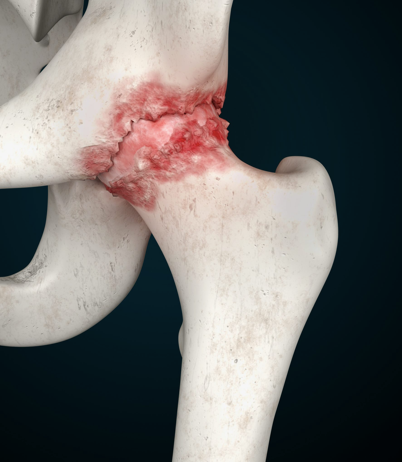Hip Arthritis
What is Hip Arthritis?
Hip arthritis, also known as osteoarthritis of the hip, is a degenerative disease affecting the hip joint. The hip joint is a ball and socket joint that connects the thigh bone to the pelvis.
This joint allows for a wide range of motion, such as walking, running, and jumping. However, with hip arthritis, the cartilage that cushions the joint deteriorates, leading to pain, stiffness, and inflammation.
How Does Hip Arthritis Impact Your Anatomy and Health?
Hip arthritis can cause significant discomfort and pain in the hip joint, making it difficult to perform everyday tasks such as walking, climbing stairs, and standing up from a seated position. The cartilage that cushions the joint can wear away, causing bone-on-bone contact and leading to inflammation and stiffness. In advanced stages, the bone spurs can form around the joint, reducing mobility and increasing pain.
What are the Types of Hip Arthritis?
There are three types of hip arthritis:
- Osteoarthritis is the most common form of hip arthritis and occurs when the cartilage that cushions the joint deteriorates over time due to wear and tear. It can be secondary to multiple predisposing hip conditions such as
- Hip Dysplasia
- Crystal Arthropathies - Gout and pseudogout disease
- Post -septic arthritis
- Post- paediatric hip disorders
- Rheumatoid arthritis is an autoimmune disorder in which the body's immune system attacks the joints, leading to inflammation and cartilage loss.
- Post-traumatic arthritis develops after a hip injury, such as a fracture or dislocation, and can cause damage to the joint surface, leading to arthritis over time.
Risk Factors for Hip Arthritis
Hip arthritis can affect people of all ages and genders. However, some factors increase the risk of developing hip arthritis, such as age, obesity, family history of arthritis, previous hip injuries, and overuse of the hip joint. Women are more likely to develop hip arthritis than men due to hormonal changes that affect joint health. Also, they frequently have Hip Dysplasia, a secondary cause of hip osteoarthritis.
Causes of Hip Arthritis
Patients with arthritis experience pain, stiffness, and loss of movement. This is due to
- The progressive wearing of articular cartilage,
- Narrowing of the joint space, and
- The possibility of bone spurs or excessive bone growth around the edges of the hip joint.
Causes of arthritis include
- Natural Degeneration,
- Cartilage Wear Due to Advancing Age,
- Congenital or Developmental Hip Diseases,
- Overweight and obesity,
- Avascular Necrosis of the Femoral head (secondary to alcohol abuse, chronic use of steroids and coagulopathies)
- Previous History Of Hip Injury Or Fracture, and
- Increased Stress On the Hip Because Of Overuse.
Degenerative Arthritis (Osteoarthritis)
The hip joints can become worn out, most commonly due to osteoarthritis.
Cartilage Wear
As the hip cartilage is degraded over time due to osteoarthritis, it will not regenerate. This condition typically will not improve and can be painful and debilitating.
Hip Fractures
Older patients are more prone to hip fractures and deformities caused by osteoporosis as patients' bones become less dense with tissue loss and more soft and brittle. Fractures around the hip may lead to post-traumatic arthritis requiring a hip replacement.
Femoral Acetabular Impingement (FAI)
Femoral acetabular impingement (FAI) has been suggested as a cause of premature osteoarthritis. This may be the reason we see younger and younger patients developing arthritis.
Genetic
There may be a genetic tendency in some people to develop osteoarthritis. Abnormalities from some hip conditions can appear in childhood, leading to earlier degeneration. This mechanical abnormality causes excessive wear and tear.
Rheumatoid Arthritis
While the Rheumatoid Arthritis trigger is unknown, the swelling caused by inflammation of synovial joints can cause pain and, ultimately, joint degeneration. If the condition can not be treated with medication, it can give rise to Hip Replacement Surgery.
Avascular Necrosis
Avascular necrosis (AVN) can cause hip joint degeneration. This disease can cause blockage of the artery to the femoral head. Starved of nutrients, the hip’s femoral head dies and may collapse.
Most cases are without a known underlying cause. Some cases are related to medications such as corticosteroids. Excessive alcohol consumption can also lead to AVN.
Perthes’ Disease
Perthes’ disease mainly affects children (3 - 11 years old). The disease softens the femur ball due to a poor blood supply. While most Perthes’ disease sufferers recover and regenerate bone, the disease can leave lasting damage.
Slipped Capital Femoral Epiphysis
Early development problems of the femoral head can give rise to hip problems for patients in their teens. The ball slides out of position, causing the leg to turn outward. Contributing factors to this condition include increased hormones and weight gain with age.
Without treatment, slipped capital femoral epiphysis can worsen, and the child may experience arthritis of the hip joint later.
Dysplasia and Congenital Dislocation
Developmental problems of a newborn’s joint can cause dislocations because of a shallow socket. This form of dysplasia prevents a stable fit. Causes for developmental dysplasia include breech births, family history and other disorders such as spina bifida.
Slack ligaments may also allow the femoral head to slip out of the joint.
Ankylosing Spondylitis
While an uncommon form of inflammatory arthritis, it can affect hips.
Typical symptoms include pain and stiffness first thing in the morning. Ankylosing spondylitis can occur by itself or in association with other disorders, including Crohn’s disease, ulcerative colitis and psoriasis.
Symptoms of Arthritis of The Hip
Common Arthritis symptoms include
- Pain in the hip joint (particularly in the groyne)
- Pain radiating pain from the hip to thigh and knee
- ‘Clunking’ in the hip
- Pain when starting a movement, such as from sitting to standing position
- Difficulty walking resulting in a limp
- Muscle stiffness
The pain is often made worse with a simple activity like putting weight through the hip such as when arising from a chair. This is called start-up pain.
Hip pain can also be felt down the front of the leg and buttock (although problems with the lower back can also cause pain in this area). This is called referred pain, and it’s relatively common.
Other prolonged symptoms can include
- Loss of full range of motion
- Inability to either bend or fully straighten the hip
- Tendency for your hip to get "stuck" or lock up
- Audible ‘clicking’ or a sense of ‘grating’
- Difficulty putting on shoes and socks
Stages of Hip Arthritis
Hip arthritis can progress through four stages:
- Stage 1: Minor cartilage damage with no bone-on-bone contact. Symptoms may be mild, and joint function is not significantly impacted.
- Stage 2: Mild to moderate cartilage loss with some bone-on-bone contact. Symptoms may include pain, stiffness, and reduced mobility.
- Stage 3: Moderate to severe cartilage loss with significant bone-on-bone contact. Symptoms may include severe pain, stiffness, and reduced mobility.
- Stage 4:
Severe cartilage loss with bone-on-bone contact, bone spurs, and significant joint damage. Symptoms may be severe, and joint function may be severely impacted.

Diagnosis of Hip Arthritis
Your doctor will need to diagnose the specific nature of your hips disorder or the extent of any osteoarthritis in the hip joint; a clinical diagnosis is made by:
- Taking a Medical History
- Performing a Medical Examination.
- Joint Range of Motion Assessment
- Pathology Testing, but there is no blood test for osteoarthritis
Imaging tests
To understand the nature of the condition. Imaging scans may be required:
- X-rays do not show cartilage but are often normal as they can help rule out other problems with the hip that may have similar symptoms like fractures (broken bone), joint space, bony spurs and arthritic cysts. Special x-rays incidences required are
- AP pelvis
- AP and lateral x-ray of ipsilateral hip
- Sitting and standing lateral x-rays of spine-pelvis
- MRI can create detailed images of hard and soft tissues within your hip. An MRI can produce cross-sectional images of internal structures required if the diagnosis is unclear or if other soft tissue injuries are suspected, such as ligament injuries, articular cartilage wear, and labral tears. MRI is not always recommended, only when plain x-rays are not able to make the diagnosis
- Ultrasound can allow your doctor to examine the inside of your hip in motion. This can help determine if you have a loose flap of cartilage getting caught between the moving parts in your Hip. There are very limited indications for the diagnosis of trochanteric bursitis and gluteal tendinopathy.
While not all of these approaches or tests are required to confirm the diagnosis, this diagnostic process will also allow your doctor to review any possible risks or existing conditions that could interfere with the surgery or its outcome.
Hip Arthritis Treatment Options
After your condition has been assessed, you will be advised of this Clinical Assessment and also have your treatment options explained.
Hip arthritis can be treated with various approaches, depending on the severity of the condition. The available treatment options include:
- Lifestyle modifications: Losing weight, avoiding activities that worsen symptoms, and engaging in low-impact exercises, such as swimming or cycling, can help reduce pain and improve joint function.
- Medications: Over-the-counter pain relievers, such as acetaminophen or ibuprofen, can help relieve pain and inflammation. Prescription medications, such as corticosteroids or disease-modifying anti-rheumatic drugs, may be prescribed for more severe cases. Speak to your doctor first.
- Physical therapy: Exercises to improve joint flexibility, strength, and range of motion can be prescribed by a physical therapist.
- Injections: Corticosteroid injections or viscosupplementation injections may sometimes relieve pain and inflammation. They should be delivered under imaging by an experienced radiologist. Speak to your doctor or surgeon first.
- Surgery: In advanced stages of hip arthritis, surgery may be necessary to replace the damaged joint with an artificial joint.
What if Hip Arthritis is Untreated?
Untreated hip arthritis can lead to significant joint damage, reduced mobility, and chronic pain. The joint damage may be irreversible, and the symptoms may worsen over time, leading to disability. In severe cases, hip arthritis can lead to secondary conditions, such as bursitis, tendinitis, or nerve damage. Therefore, it is crucial to seek treatment for hip arthritis as soon as possible to prevent further damage and improve joint function.









